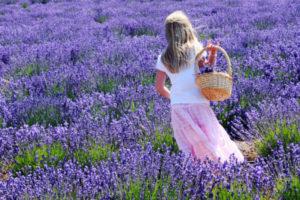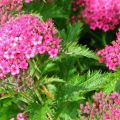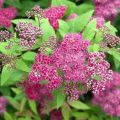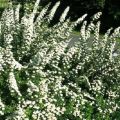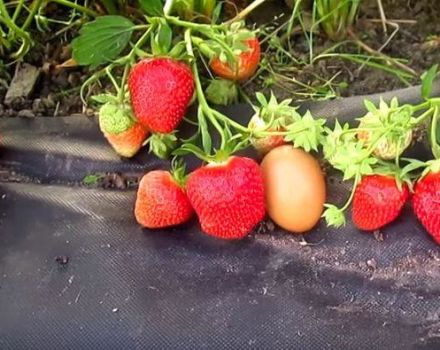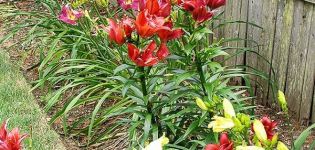Characteristics and description of the Antoni Vaterer variety spirea, planting and care
The spirea shrub is replete with a variety of varieties, the most popular of which is Antoni Vaterer. The compact bush has long become a favorite of landscape designers due to its bright colors, which is why it is often found in summer cottages or in park areas. Another positive quality of the plant is its unpretentiousness, which is why when choosing colored bushes for the garden, summer residents stop at spirea.
Description and characteristics of the plant
Spirea Anthony Vaterer or Anthony Waterer is a hybrid of white-flowered and Japanese spirea. The plant is very compact, the crowns do not reach more than 80 centimeters. The shrub grows slowly and rarely grows more than 5 centimeters per year. The shape of the bush is spherical, with straight branches.
Leaves are pointed, serrated. When blooming, they have a scarlet hue, then they become dark green, and in the fall, before falling off, they are filled with red. Spirea flowers are small, bright pink, with a lilac tint. Collected in lush, covering the plant, inflorescences, with a diameter of about 15 centimeters. The flowering period is 100 days, from June to September.
Important! With regular pruning of fading inflorescences, the flowering period is extended.
Advantages and disadvantages of spirea Anthony Vaterer
The Anthony Vaterer shrub has a number of undeniable advantages:
- long flowering;
- unpretentiousness;
- compactness;
- frost resistance;
- disease resistance with proper care;
- low cost of seedlings;
- suitable for single and group landings;
- beautiful appearance and pleasant smell.
Despite the positive aspects, the spirea still has several disadvantages that should be described:
- in a drought, additional watering is necessary, otherwise the plant will dry out;
- with improper care, there is a high probability of infection of the bush with a fungus and an invasion of pests.
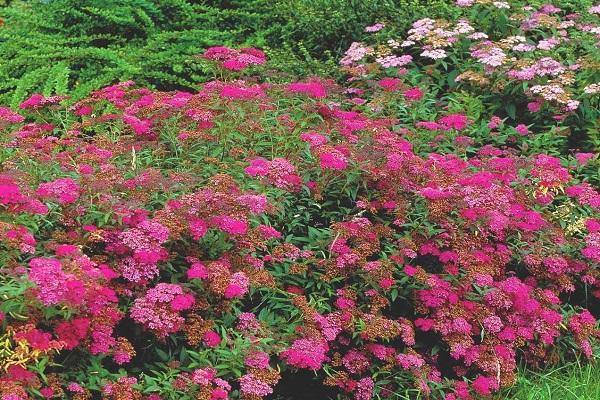
Features of growing varieties
In order for the bush to grow healthy and resistant to disease, planting rules should be followed.
Time and place
The recommended planting time for the shrub is in September, when the sun is less scorching. Spirea is a light-loving plant, therefore the most advantageous place is unshaded, which is illuminated all day. The soil should be sod or leafy, without groundwater and with the greatest fertility. Be sure to add peat and sand to the soil before planting.
Important! The more fertile the earth is, the more magnificent and abundant the spirea will bloom.

Preparation of planting material
For planting spirea, you should choose a cloudy or rainy day in September.Suitable material for planting or transplanting is strong healthy shoots or well-rooted seedlings. When digging out of the soil, the root system should be preserved as much as possible without damaging. Sick, dry and weak shoots should be cut off. Cut strong seedlings should be soaked in succinic acid for half an hour before planting.
If the seedling is bought in a store, you need to make sure that there is no external damage to both the root system and the shaft itself.
Planting scheme and process
Before planting the plant, the soil must be dug up and fertilized with sand and peat or humus, and then proceed to digging the planting holes. They should be about 50 centimeters deep and half the width of the root system. The distance between the planting pits is at least half a meter. The bottom of the holes should be drained, especially if groundwater is leaking in the ground. For this, expanded clay or small pebbles are suitable.
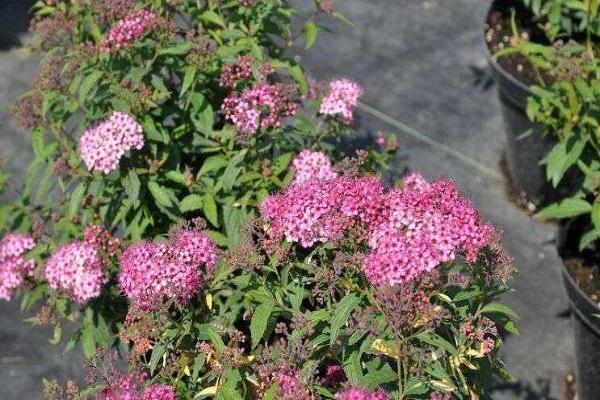
The roots of the seedling should be distributed over the hole so that they feel free, and the bark neck is at the level of the ground or slightly higher. After the future bush is sprinkled with earth, fertilized with sand and peat, and then well tamped. When everything is ready, the seedling should be watered with a bucket of water and covered with peat.
Care advice
In order for a flowering plant to please its owners, you need to follow simple rules for care.
Watering and feeding
As already mentioned, spiraea does not like severe drought, therefore, in especially hot summer, the plant should be watered twice a month, and bushes under 3 years old - once a week. Watering is also necessary in the first year of the shrub's life. A bucket of water is enough. Before this, the soil must be dug up so that the liquid does not stagnate, and after watering it must be mulched with sawdust or peat in order to avoid drying out.
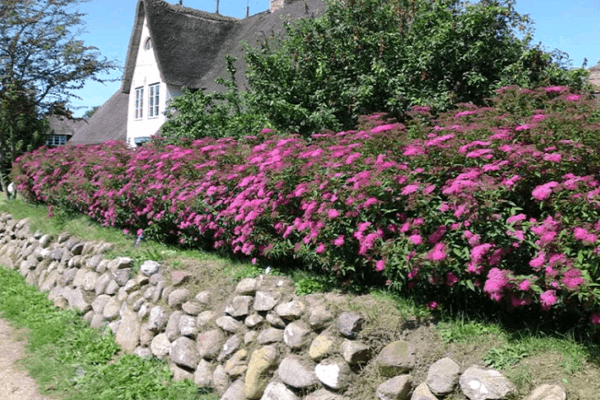
Also, don't forget about feeding. Potash, phosphate, nitrogen or mixed fertilizers should be applied twice a year. The first time in spring - before bud formation, the second time - in June, before flowering.
Loosening and pruning
Loosening of the soil is carried out in spring, autumn, during watering and before mulching. This will saturate the soil with oxygen, prevent liquids from accumulating, prevent the appearance of fungus and reduce the risk of parasites.
Pruning is another important consideration when caring for a spirea. Regular trimming of the bush will enhance plant growth, increase the number of inflorescences and protect against premature wilting. Pruning is carried out in the spring - before the buds appear, or in the fall - when the bush has faded:
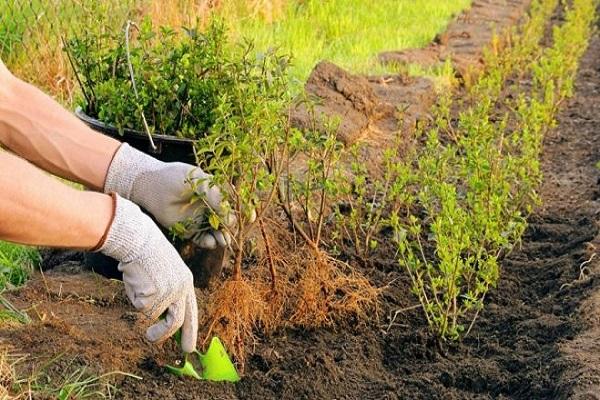
- dry and painful branches are cut off completely, and old ones are shortened;
- the older the bush, the more abundant the pruning - a plant older than 5 years is shortened to 50 centimeters, and older than 6 - it is cut completely to the stump. Shearing of old plants is carried out only in autumn.;
- in spirea older than 3 years, the lower shoots and old branches are cut off.
The resulting cuttings should be burned.
Winter care
Spireas are frost-resistant, but young bushes need additional heating. Before the onset of cold weather, seedlings and young bushes are covered with spruce branches or foliage, and after precipitation they should be covered with snow.
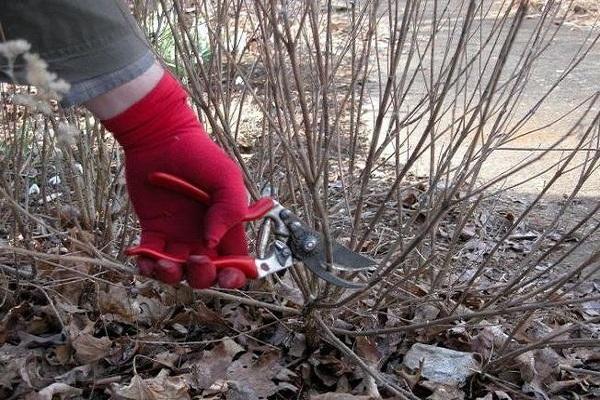
Diseases and pests
An infection that can attack spirea is fungus or root rot. To avoid this, you should avoid stagnant water, regularly dig up and mulch the ground. With regards to parasites, the most dangerous for the shrub:
- aphids (the peak of infection is in the summer months, untimely treatment is fatal to the plant);
- spider mite (no less dangerous than aphids, and also leads to the death of a flowering bush; calmly survives the cold in the leaves);
- leaf rollers;
- miners.
To avoid an invasion of pests, you should carefully monitor every change in leaves, stems and flowers, and also regularly prune the plant, loosen and mulch the soil.
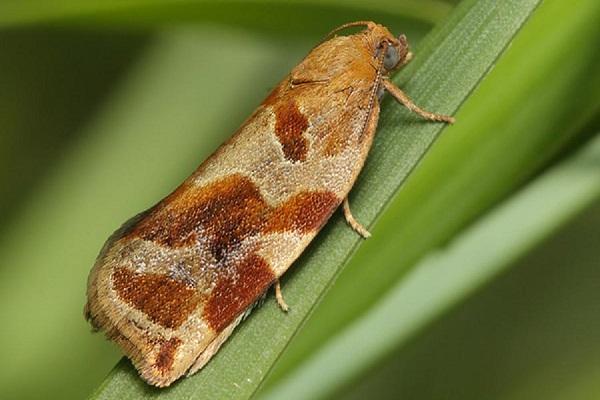
Bush propagation
How to propagate spirea yourself:
- taps: such a division is carried out in the spring, choosing young and strong shoots. The bends should be carefully bent to the soil, until they touch, and fixed, and then covered with earth along the entire length. Water the shoots 2 times a month. For the winter - cover with foliage or peat. In the new spring, the young bush can be separated from the mother and transplanted to a new place;
- cuttings: this method is carried out in June, when the young branches are finally formed into a full-fledged branch. To do this, they are cut off and divided into small processes, about 10 centimeters long. After that, the cuttings should be dipped in a solution that stimulates growth for 12 hours, then planted in soil fertilized with peat and sand, watering every two days.
Antoni Vaterer will not be able to increase the number of plants on the plot with seeds, since this species is hybrid, and one of the parents of this variety will turn out from the grains.
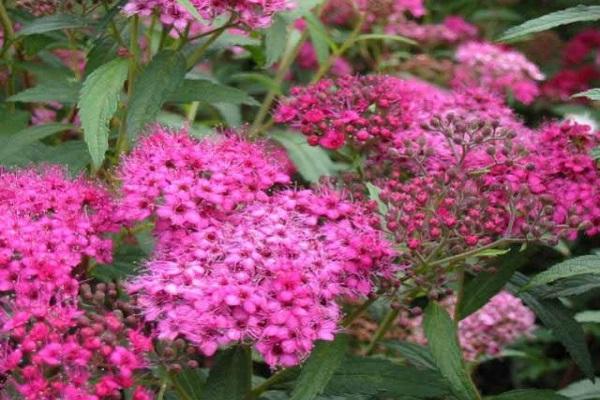
Landscape design
Most often, spirea is used in landscape design, as a hedge, or planted along alleys. The bush goes well with conifers and other trees, which allows designers or simply creative people to create a real plant picture.
